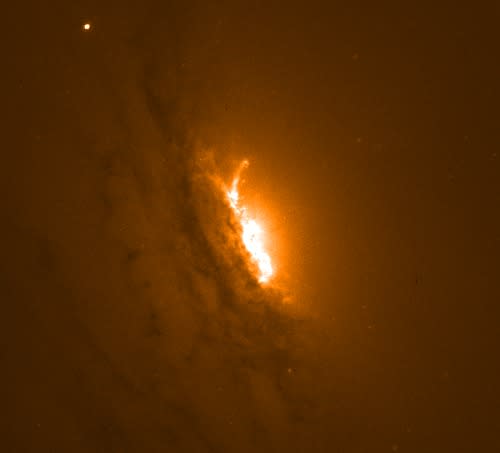Here’s Why Some People Think The Large Hadron Collider Will Kill Us All

Ominous clouds burning with blue lightning flashes gathered over the Large Hadron Collider this week - and soon, conspiracy theorists swore they could see faces in there.
Had CERN opened a gateway into a terrible, infernal dimension? Had Satan himself arrived?
As usual, the answer was no: it was just a cloud over the 16-mile ring near Geneva, shot to make it look as ominous as possible.
But ever since the collider - the most powerful ever built - switched on, people have been terrified of it - claiming that black holes are going to swallow Earth, and that the scientists secretly have a statue of an Indian god of destruction in the facility.
Religious conspiracy theory fans Freedom Fighter News said this week, ‘They just began, running this crazy amount of energy through the AWAKE experiment. They keep messing with nature and denying it… and here is yet more proof. What is in the clouds? ‘
But why are people so scared of the LHC? And why DO the scientists have a statue of a God of destruction in there?
Why people fear CERN and the LHC

Many people seek to tie the Large Hadron Collider to ancient prophecies - or to various unsavoury deities.
Clyde Lewis wrote on the Ground Zero website , ‘Is it just a coincidence that CERN is short for the horned God Cernunnos? Is it also a coincidence that CERN has to go deep underground to do their “god” harnessing experiments? Cernunnos was the god of the underworld.’
Nigel Watson, author of the UFO Investigations Manual, says that the phenomenon is similar to belief in alien spacecraft - and likewise grounded in a fear of technology.
Watson says,, ‘CERN is linked with all manner of conspiratorial and apocalyptic fears.
‘As with other perceived horrors of science and technology there is always a belief that they will bring about our ultimate destruction and salvation will only exist for the chosen few. The CERN project rather than atomic warfare or pollution is now the focus for such fears.’
Who stirs up the rumours?

It seems that Christian conspiracy theorists haven’t forgiven the infernal machine for finding the ‘God particle’ - many of the claims about CERN opening ‘cosmic gateways’ come from religious conspiracy theorists.
In September 2015, conspiracy theorists widely predicted that the Large Hadron Collider would be involved in the end of the world - either by summoning an asteroid, or the Antichrist himself.
YouTubers Section 51 said at the time, ‘People have become more aware of the CERN project’s aggressive ambitions to explore the unknown ‘dark universe” many have pointed to signs that have people troubled if not terrified by the parade of symbolism used at the CERN facility itself.
‘At CERN headquarters a symbol of Shiva, the (Hindu God of Destruction) dancing the cosmic dance of death and destruction can be clearly seen at the CERN facility. Is this a Symbolic declaration of CERN’s ultimate intention to bring on a new age of destruction to this planet?
God of destruction

One part of the conspiracy theories is actually true - there genuinely is a statue of Shiva at CERN, portrayed online as a ‘God of destruction’.
But the statue - a gift from the Indian government - is one of many on display in CERN’s facility, and is not meant to evoke destruction at all.
CERN explains, ‘In the Hindu religion, this form of the dancing Lord Shiva is known as the Nataraj and symbolises Shakti, or life force. As a plaque alongside the statue explains, the belief is that Lord Shiva danced the Universe into existence, motivates it, and will eventually extinguish it. Carl Sagan drew the metaphor between the cosmic dance of the Nataraj and the modern study of the ‘cosmic dance’ of subatomic particles.’
Black holes

Conspiracy theorists feared that when the Large Hadron Collider switched on, it would produce an enormous black hole, sucking us all into it.
That hasn’t happened, obviously - and nor has the LHC produced any of the microscopic black holes that many expected, according to University of Alabama researchers.
But it still could produce tiny black holes - which would give scientists a new way to investigate gravity, and prove the existence of extra dimensions, the scientists believe.
The University of Alabama’s Shaqoi Hou and Benjamin Harms and the University of Mississippi’s Marco Cavaglia believe that so far, the LHC has not produced any black holes.
The researchers believe they have ruled out black holes with 95% certainty, by comparing simulations of black hole formation, with real data from LHC experiments.
The researchers write that it’s still possible that the LHC could produce microscopic black holes.
Parallel universes

There is actually a chance CERN will discover a parallel universe - something which conspiracy theorists seized on as evidence that the scientists were up to something evil.
But the reality of parallel universes is somewhat different from what we see in science fiction - and there’s no chance we will all wake up to find Hitler won the war.
'Just as many parallel sheets of paper, which are two dimensional objects (breadth and length) can exist in a third dimension (height), parallel universes can also exist in higher dimensions’ Cern employee Mir Faizal from the University of Waterloo said.
'We predict that gravity can leak into extra dimensions, and if it does, then miniature black holes can be produced at the LHC.’
'This cannot be tested and so it is philosophy and not science.This is not what we mean by parallel universes.
'What we mean is real universes in extra dimensions,’
One of the many mind-scrambling ideas on the table is that the Big Bang never happened, and the universe has always existed.
The LHC could actually save lives
Far from seeking to kill us all, the scientists at CERN hope that discoveries from the tunnels could actually change the world.
In a 2014 interview, CERN scientist Dr Harry Cliff said that the discoveries of seemingly obscure particles can change the world profoundly.
'One-hundred-odd years ago, when the first particle - the electron - was discovered, it was seen as the plaything of scientists with little practical use,’ Dr Cliff says.
'Today, most of our technology is based on understanding the electron – from the microchip to medical imaging. In a few decades time, what we find at the LHC could lead to huge technological advances, but it’s hard to know what they’ll be in advance.
'Building these huge machines forces you to develop really novel technologies, which have already led, for example, to more effective forms of cancer therapy that use beams of particles to kill tumours.’


